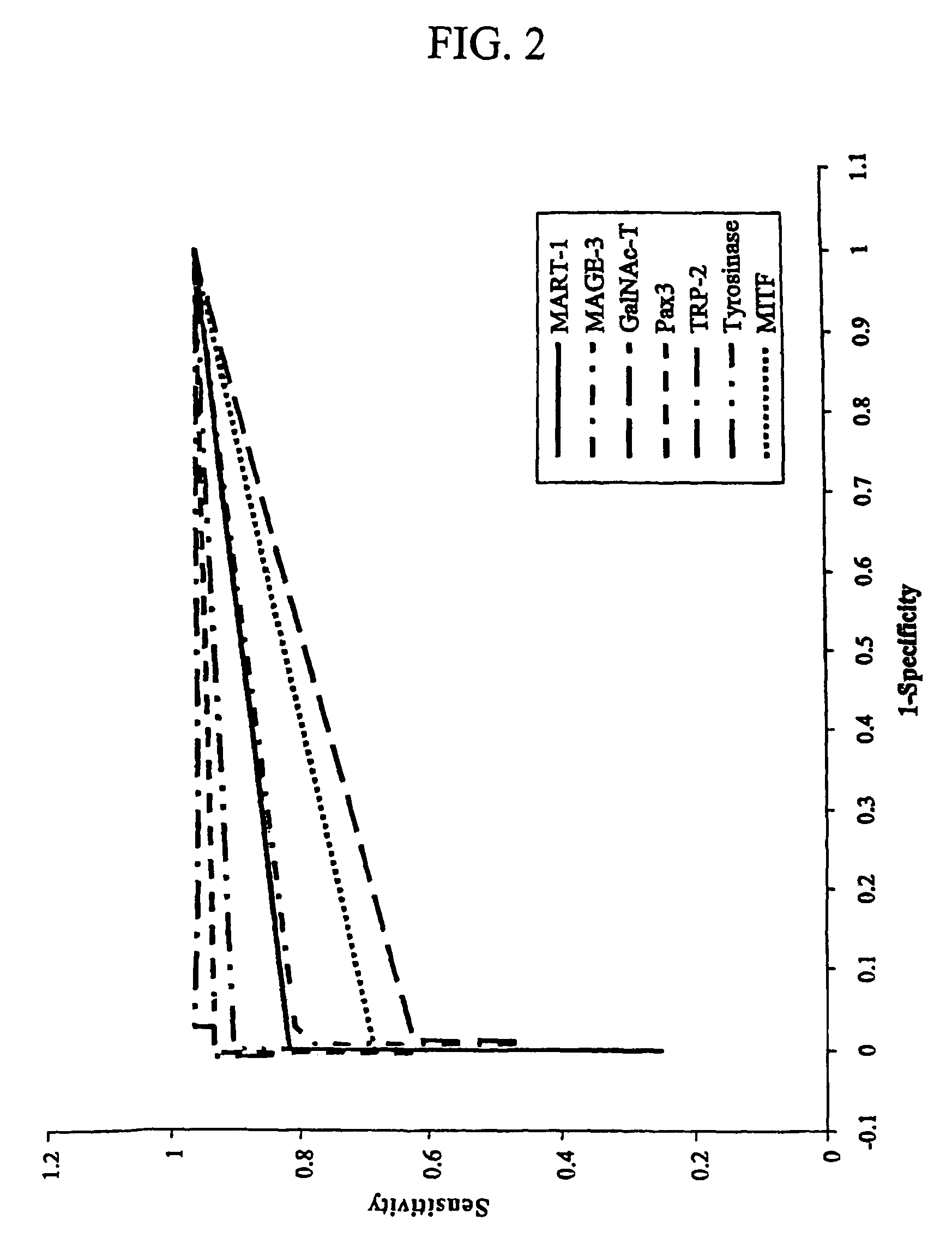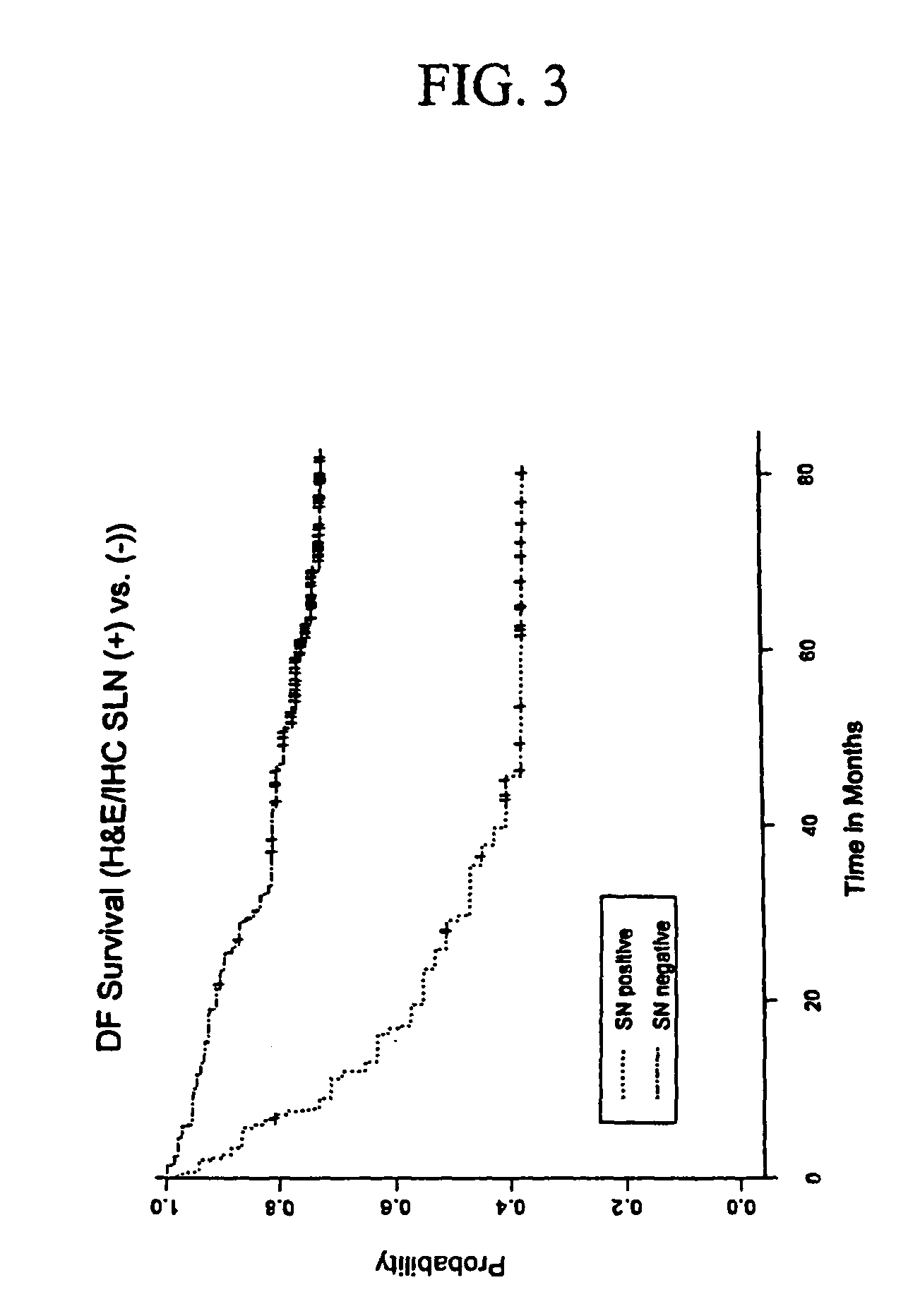Detection of micro metastasis of melanoma and breast cancer in paraffin-embedded tumor draining lymph nodes by multimarker quantitative RT-PCR
a technology of paraffin-embedded tumors and micro metastases, applied in the field of micro metastasis detection of melanoma and breast cancer, can solve the problems of malignant neoplasms' tendency to disseminate cells, high labor intensity of approaches, and often underestimate the presence of micrometastatic disease in procedures. , to achieve the effect of accurate determination, high sensitivity and specificity
- Summary
- Abstract
- Description
- Claims
- Application Information
AI Technical Summary
Benefits of technology
Problems solved by technology
Method used
Image
Examples
example 1
Patients and Tumors
[0060]SLN specimens were obtained in consultation with the surgeon and pathologist at the John Wayne Cancer Institute (JWCI). Informed human subject IRB consent was obtained from patients for the use of all specimens. All patients had AJCC stage I or II malignant melanoma (staged by current AJCC staging system) (Balch, C. M., 2001) which are defined as those patients with no clinical evidence of regional or metastatic disease. SLND was performed in the patients as previously described (Morton, D. L., 1992). Total 308 SNs obtained from 215 patients were assessed for histopathologic examination and qRT-PCR assay. The patients ranged in age from 18.7 to 91.3 years old (mean age 50.9±15.9 SD), consisting of 127 males and 88 females. The patients who had histopathologically (H&E / IHC) proven metastatic melanoma in SLNs at SLND subsequently received complete lymph node dissection of the lymphatic basin. Patients were followed up by clinical diagnostic examinations in the...
example 2
Histopathologic Examination and RNA Isolation
[0063]Histopathologic examination by the pathologists was performed on each collected SN as previously described (Bostick, P. J., 1999, which is incorporated herin by the reference). Each SN was bisected, and an 8-μm imprint slide was then prepared from the tissue surface and stained with Diff-Quik I & II (Dade International, Miami, Fla.) for the pathologist's intraoperative diagnosis. If melanoma cells were identified in the frozen section, a complete lymph node dissection was then performed (Bostick, P. J., 1999). Six immediately adjacent frozen sections were cut on the cryostat to a thickness of 12 μm each and stored at −80° C. until processed at a later date (Bostick, P. J., 1999; Miyashiro, I., 2001). The remainder of the bisected node, which was not frozen, was then placed in 10% formalin and embedded in paraffin, and 4-μm-thick sections were examined with H&E staining. Adjacent 4-μm-thick sections werre evaluated by IHC using antib...
example 3
Dilution Study
[0065]To verify the specificity of detecting occult metastasis, total RNA was extracted from 1000 melanoma cells of obviously metastatic melanoma tissue (n=8) in PE sections using laser capture microdissection (LCM). Five-μm thick sections were cut from each tissue specimen embedded in paraffin using a microtomb and mounted on a slide. Then, tissue sections were deparaffinized with xylene and subsequently stained with H&E. After drying a slide, 1000 metastatic melanoma cells were microdissected using the PixCell II LCM System (Arcturus Engineering, Mountain View, Calif.) as manufacture's procedure. Microdissected tissues were digested with proteinase K and total RNA was extracted using the Paraffin Block RNA Isolation Kit (Ambion). RNA isolated from 1000 melanoma cells was dissolved in molecular grade water, and was serially diluted by ½, 1 / 10, 1 / 20, 1 / 50, 1 / 100, 1 / 500, and 1 / 1000. Reverse transcriptase reaction and qRT-PCR assays were performed for each marker on the ...
PUM
| Property | Measurement | Unit |
|---|---|---|
| thickness | aaaaa | aaaaa |
| volume | aaaaa | aaaaa |
| thick | aaaaa | aaaaa |
Abstract
Description
Claims
Application Information
 Login to View More
Login to View More - R&D
- Intellectual Property
- Life Sciences
- Materials
- Tech Scout
- Unparalleled Data Quality
- Higher Quality Content
- 60% Fewer Hallucinations
Browse by: Latest US Patents, China's latest patents, Technical Efficacy Thesaurus, Application Domain, Technology Topic, Popular Technical Reports.
© 2025 PatSnap. All rights reserved.Legal|Privacy policy|Modern Slavery Act Transparency Statement|Sitemap|About US| Contact US: help@patsnap.com



